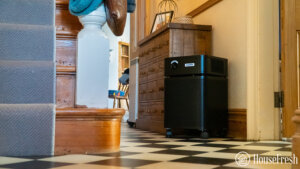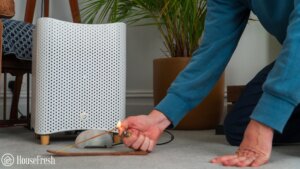Nothing beats drawing a nice hot bath after a long day. The candles are lit, your favorite album is on, and the bubble bath has been generously applied. Yet nothing kills the mood quite as quickly as looking up to see mold and mildew growing on your walls and ceiling.
Despite bathrooms being temples of cleanliness (student dorms and bachelor pads excluded), they can often be plagued by black mold. The humid air hitting cold surfaces results in condensation, providing fertile ground for mold to grow. If left unchecked, mold will not only be an unsightly feature of your bathroom but can rot furnishings and trigger allergic reactions, asthma, and other respiratory problems.
While you always try to add ventilation using a high-power bathroom fan, if this isn’t possible, a dehumidifier is a very effective way to remove this moisture before it damages your home or health.
Bathroom sizes in the United States range from small (35 sq. ft.) to very large bathrooms (210 sq. ft.) You will see many dehumidifiers are recommended for far bigger spaces than that. Still, you need to be aware that these recommendations are made without assuming the unit will be used to help dehumidify a bathroom.
A large dehumidifier will be very effective at removing lots of moisture but will also come with higher sound levels and a big increase in your electricity bill; a 500-watt device could add over $500 to your electricity bill with continuous use.
In general, try to choose the smallest dehumidifier that can still remove enough water from the air in your bathroom.
While small dehumidifiers seem like the perfect fit for bathrooms, we suggest ignoring the many mini dehumidifiers on the market and looking at the mid-sized devices that can remove much more water and still run quietly without using too much energy.
Those with very large, humid bathrooms will want to look for compressor-based units with at least 22 pints of water removal.
Staff picks: Top 3 dehumidifiers for the bathroom
This review is over 5000 words so if you just want to read it all, then these are the 3 bathroom dehumidifiers we recommend:
| BEST OVERALL | MEDIUM-SIZED BATHROOM | LARGE BATHROOM | |
|---|---|---|---|
| ToLife TZ-C2 | GE 20 Pint | Honeywell TP30WKN | |
 |  |  | |
| WATER REMOVAL (24 HOURS) | 2.1 pints (1 liter) | 20 pints (11.36 litres) | 30 pints (17 litres) |
| WATER BUCKET | 95 oz (2.8 litres) | 98 oz (2.78 litres) | 134 oz (4 litres) |
| MAX SOUND | 40 dB | 52 dB | 51 dB |
| MAX ROOM SIZE | 250 sq. ft. (24 mᶟ) | 1500 sq. ft. (139 mᶟ) | 1000 sq. ft. (93 mᶟ) |
| WEIGHT | 5.99 lbs (2.71 kg) | 30.99 lbs (14 kg) | 42.9 lbs (19.5 kg) |
| PRICE | $99.99 | $172.20 | No products found. |
Last update on 2024-04-17 / Affiliate links / Images from Amazon Product Advertising API
If you want to find the right dehumidifier for your bathroom, then be sure to check out our full list based on our hands-on research:
1. Best overall: ToLife TZ-C2
A new type of “mid-sized” dehumidifier that is perfect for the bathroom

There used to be a gap in the size of dehumidifiers sold. You had the mini devices like the popular Pro Breeze (which can remove a pint of water in 24 hours) and then the larger devices (which could remove 20 to 70 pints a day), but there was a big gap in between.
You were then forced to pick between an underpowered dehumidifier or a much larger device than you needed, which was a lot noisier and usually too big for rooms like a bathroom.
The TZ-C2 by ToLife changed all that. The ToLife TZ-C2 is bigger than mini-style units but much more powerful without making a lot of noise, compared to the standard compressor-style dehumidifiers.
According to the information on the ToLife website, the TZ-C2 can remove up to 1000ml of water a day in rooms with 80% relative humidity.
We were keen to see if the real-life performance of this dehumidifier matched this figure from their marketing materials, so we tracked how long it could reduce humidity in our grow tent. The TZ-C2 brought the relative humidifier down to 55% in 39 minutes and to 51% within 190 minutes:
What we really like
What we think could be better
Something quite cool about the ToLife TZ-C2 is that the light behind the water tank rotates through seven different colors. But if feeling like you’re inside a disco is not for you, you can simply lock the color you like most or even turn off the light completely.
You can also select a night mode that brings the sound generated to less than 30dB, but even at its highest fan speed, it’s only 40dB, which is much less than what we find with compressor-style devices.
At maximum wattage, this dehumidifier will pull up to 98 watts which equates to just over an extra $100 on your energy bill if you use it 24 hours every day of the year.



SPECS & FEATURES
| HouseFresh rating: | ★★★★☆ |
| Water it can remove in a day: | 2.1 pints (1 liter) |
| Recommended room size: | 250 sq. ft. (24 mᶟ) |
| Water tank capacity: | 95 oz (2.8 litres) |
| Dimensions (in inches / in cm): | 8.27D x 5.55W x 13.78H inches (21 x 14 x 35 cm) |
| Weight (in pounds / in kg): | 5.99 lbs (2.71 kg) |
| Noise levels: | 30 — 40dB |
| Other features: | Portable with a removable tank, automatic shutoff and sleep mode. |
| Warranty | 1 year |
2. Best for small bathrooms: NineSky H2
Another mid-sized dehumidifier that is perfect for small bathrooms

The NineSky H2 is a dehumidifier capable of removing up to one liter (34oz) of water a day without generating much noise (less than 40dB), making it a great choice for a bathroom.
When we reviewed this device, we were impressed with how compact and light it is. It looked a lot larger in the marketing materials from NineSky. I was pleasantly surprised during the unboxing as it is challenging to find a dehumidifier that would fit small bathrooms.
Compared to the ToLife TZ-C2, the NineSky H2 has a slightly bigger water tank (98oz) and it comes with a handy light that lets you know when the tank is full and needs emptying.
What we really like
What we think could be better
There are 4 LED light options, and you can even have it flashing if you like the disco style. Design-wise, it’s small, looks more interesting than your standard beige compressor-style unit, and would be a talking point for people visiting your bathroom.
Be aware this device only pulls 60 watts at max wattage, so will have a similar cost to running a light bulb – much less than traditional compressor-style devices.



SPECS & FEATURES
| HouseFresh rating: | ★★★☆☆ |
| Water it can remove in a day: | 2.1 pints (1 liter) |
| Recommended room size: | 250 sq. ft. (24 mᶟ) |
| Water tank capacity: | 98 oz (2.78 litres) |
| Dimensions (in inches / in cm): | 10L x 6.1W x 14.2H inches (25.4 x 16.25 x 36 cm) |
| Weight (in pounds / in kg): | 6.99 lbs (3.17 kg) |
| Noise levels: | 30 — 40dB |
| Other features: | Removable tank, automatic shutoff and ergonomic handle. |
3. Best for large bathrooms: Honeywell 30 Pint dehumidifier
The smallest compressor-style dehumidifier from a well-known brand that will make light work of a large humid bathroom

The Honeywell TP30WKN wasn’t voted the best dehumidifier by Consumer Reports for no reason.
Honeywell has been in the game for many decades, bringing high-efficiency dehumidifiers and air purifiers to the market. With the TP30WKN, they’re aiming at those with spaces of 1000 sqft that need moisture removal, but this unit is also perfect for the bathroom.
You might be saying to yourself, “1000 sq. ft. is a little over the top for my bathroom”, but if you plan to use your shower or bath, you will want a dehumidifier that can work quickly to remove the moisture from the air.
The Honeywell couldn’t be easier to use. The tank slides in/out easily to empty, and when it’s full, the unit will alert you and automatically shut off to ensure it doesn’t overfill and spill over. The interface on the top of the unit is also easy to operate.
What we really like
What we think could be better
You can adjust your desired humidity level using the digital display, set the timer, engage sleep mode, and it lets you know when the filter needs washing. If all that isn’t enough to convince you, it also comes with wheels and a heavy-duty handle to easily move from room to room or around your bathroom.

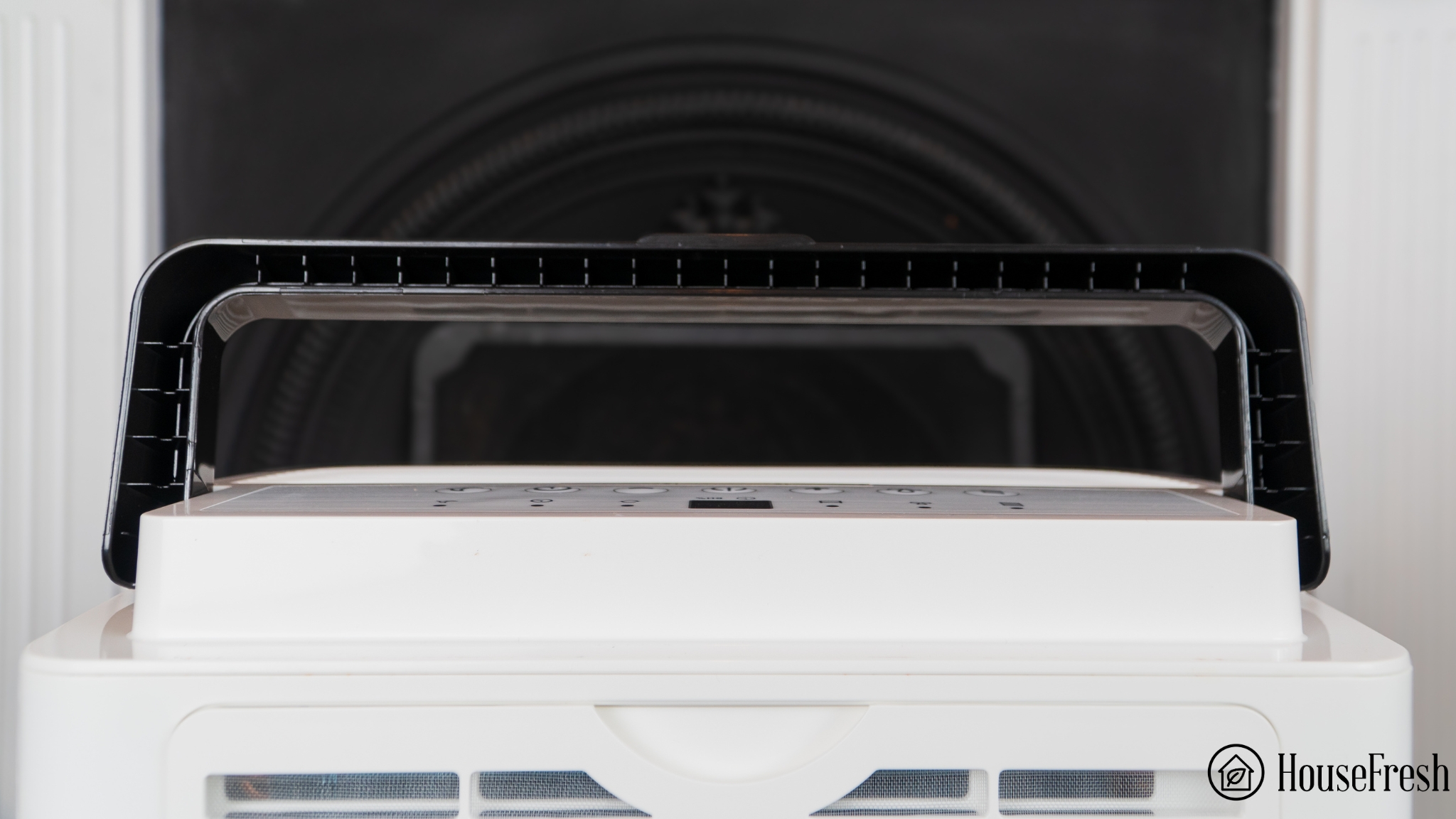

SPECS & FEATURES
| HouseFresh rating: | ★★★★☆ |
| Water it can remove in a day: | 30 pints (17 litres) |
| Recommended room size: | 1000 sq. ft. (93 mᶟ) |
| Water tank capacity: | 134 oz (4 litres) |
| Dimensions (in inches / in cm): | 10.5D x 13.2W x 20.1H inches (26.6 x 33.52 x 51 cm) |
| Weight (in pounds / in kg): | 42.9 lbs (19.5 kg) |
| Noise levels: | 40 — 51dB |
| Other features: | Full tank alert with auto shutoff, filter clean alert, auto defrost control and auto restart. |
4. Best for medium-sized bathrooms: GE 20 Pint
The smallest capacity dehumidifier from major brand GE, with a great ratio of size to water removal

This small portable dehumidifier from GE is a perfect option for medium-sized bathrooms with humidity issues. It’s fully ENERGY STAR certified and can remove up to 20 pints of water in 24 hours.
Compared to other compressor-style dehumidifiers, this is much smaller and can easily be moved around thanks to the handles on each side. It’s a super simple device with a Smart Dry function that allows you to set the humidity level in order for the onboard sensor to automatically adjust the fan speed as necessary to guarantee the target humidity level.
In our performance test, it took only seven minutes to reduce the humidity from 65% to 40%. This is a powerful device that can reduce humidity levels quickly:
What we really like
What we think could be better
As a compressor-style dehumidifier, it pulls quite a bit of power on its highest setting with up to 420 watts at max, so be aware usage may add quite a bit to your electricity bill.
Be aware that this device is small but still much louder than the first two dehumidifier options we recommend higher up this list — just to give you an idea, this dehumidifier will be as noisy as an air conditioner running in the background.



SPECS & FEATURES
| HouseFresh rating: | ★★★★☆ |
| Water it can remove in a day: | 20 pints (11.36 litres) |
| Recommended room size: | 1500 sq. ft. (139 mᶟ) |
| Water tank capacity: | 136 oz (4 litres) |
| Dimensions (in inches / in cm): | 10D x 13.5W x 19.5H inches (25.4 x 34.29 x 49.53 cm) |
| Weight (in pounds / in kg): | 30.99 lbs (14 kg) |
| Noise levels: | 48 — 52dB |
| Other features: | Alarm for emptying bucket |
| Warranty: | 1 year |
5. Best with pump: hOmeLabs 4000 Sq. Ft. 50 pint
A great option for those who want to pump water outside of the bathroom

One of the most popular dehumidifiers on Amazon thanks to its low price, high water removal capacity and features. For those with large bathrooms who can move water to an outside drain, this dehumidifier from hOmeLabs is a great option.
At just over $300 when writing this review, you get 50 pints of water removal and, more importantly, the ability to pump this water to a different location even when it’s above the device.
This Energy Star Certified dehumidifier doesn’t break the bank to operate, especially as it will clear the excess moisture from your bathroom in no time. A stand-out feature is the inclusion of the hose pump version, meaning you will never have to empty the bucket every few days.
What we really like
What we think could be better
With a maximum wattage of 540 watts, you will want to be sure you need this level of air cleaning power as will cost significantly more to run than smaller devices on this list.
This unit has a few cool features that make it stand out from the rest. It has a timer, humidity level adjuster, filter alert, and turbo mode, and hOmeLabs has treated us to a Comfort Mode. When engaged, the unit automatically sets a comfortable and healthy humidity level based on the room’s ambient temperature. Ideal for a long soak in the tub.
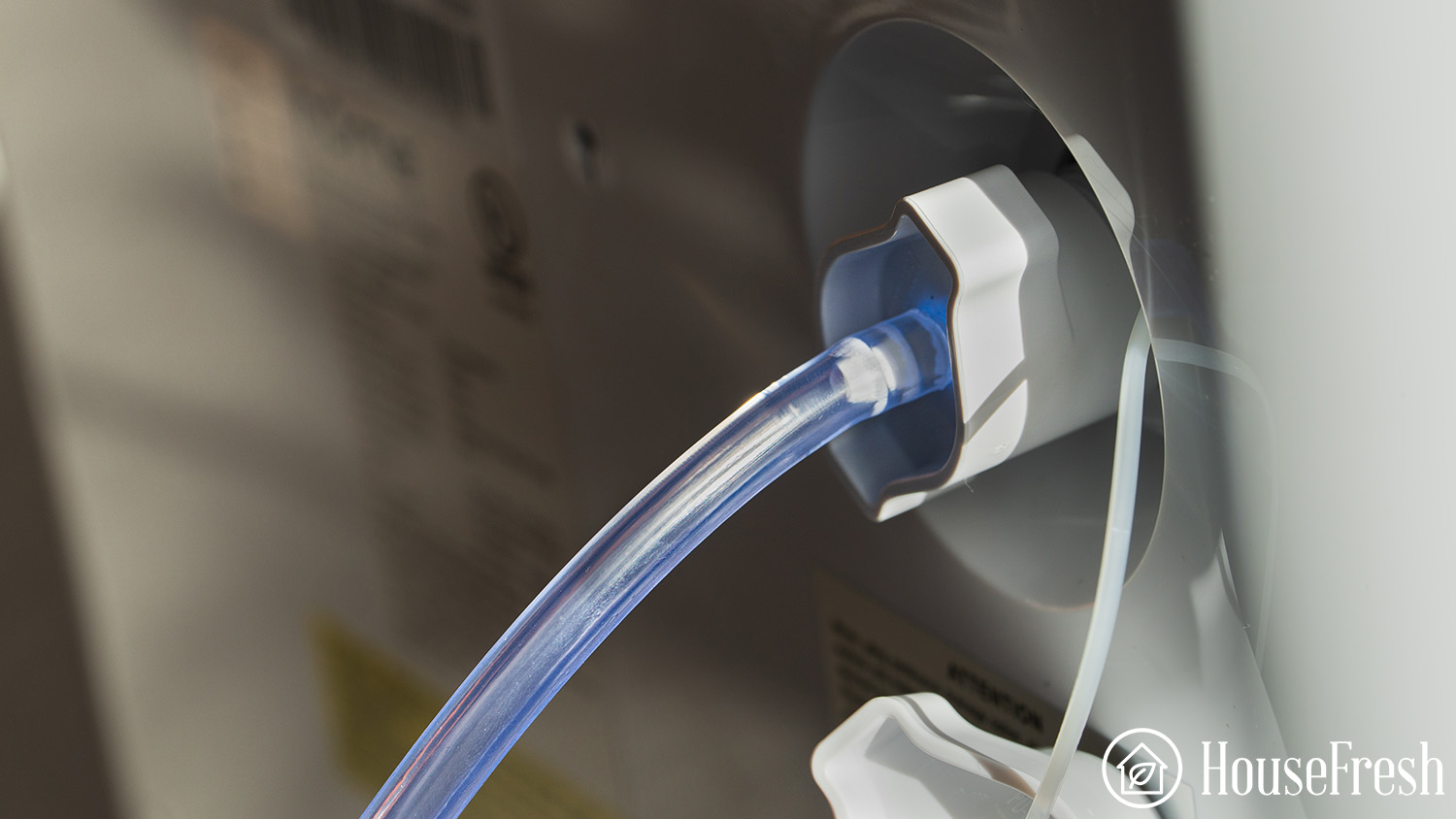

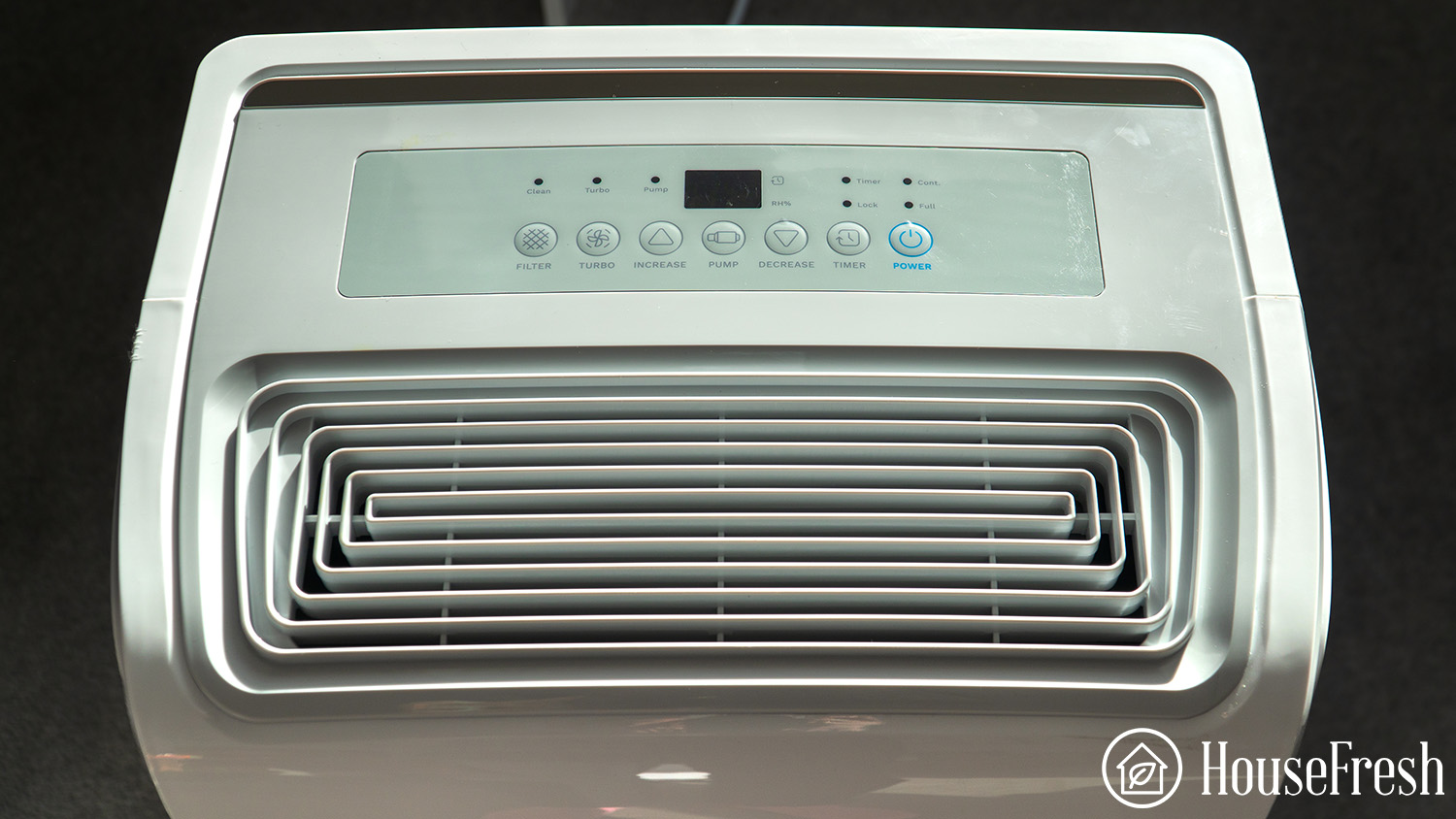
SPECS & FEATURES
| HouseFresh rating: | ★★★✩✩ |
| Water removal in 24 hours: | 50 pints (28.41 litres) |
| Recommended room size: | Up to 4000 sq. ft. (371 mᶟ) |
| Water tank capacity: | 134 oz (3.97 litres) |
| Dimensions (in inches / in cm): | 11.75D x 15.75W x 25.3H inches (30D x 40W x 64H cm) |
| Weight (in pounds / in kg): | 42.50 lbs (19.3kg) |
| Noise level full power: | 53dB |
| Energy consumption: | 520 watts (or $44 per month) |
| Warranty: | 1 year |
The one dehumidifier we don’t recommend for bathrooms: Pro Breeze Electric Dehumidifier
The Pro Breeze Electric Dehumidifier does have some pros but they don’t make up for its cons
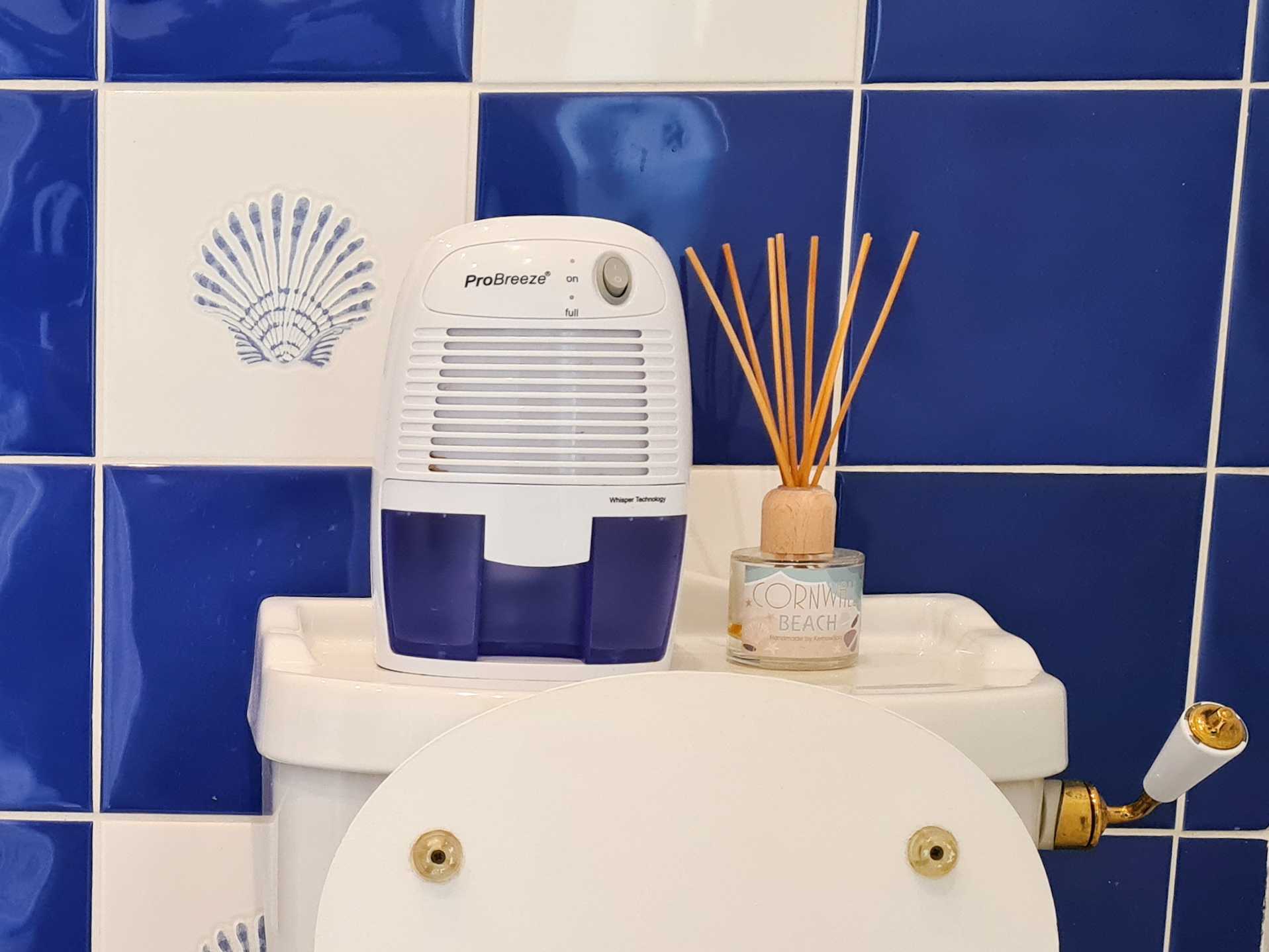
It’s portable and very easy to use. When the machine collects the maximum amount of water and needs draining, it will automatically shut off, and an LED light will turn on, notifying you. When draining, the water tank easily separates to be poured out.
What we really like
What we think could be better
The problem is, in our tests, it didn’t seem to do much at all. The price tag of the Pro Breeze tells you everything you need to know. It’s cheap and ineffective. This unit features in quite a few ‘Best’ lists from other sites, but we tested it in a real-world environment and were let down by the results.
We would highly recommend spending a little more money and investing in a unit that won’t leave you high and (not) dry.
If you have a small space and a super tight budget, then choose our top pick the ToLife TZ-C2 instead – it’s less than $80 but is much more capable of reducing humidity in your bathroom
SPECS & FEATURES
| HouseFresh rating: | ★★✩✩✩ |
| Water removal in 24 hours: | 1 pint (0.5 litres) |
| Recommended room size: | 215 sq. ft. (19 mᶟ) |
| Water tank capacity: | 16 oz (0.45 litres) |
| Dimensions (in inches / in cm): | 6D x 6W x 8.5H inches (15D x 15W x 21.5H cm) |
| Weight (in pounds / in kg): | 2.4 lbs (1.1 kg) |
| Noise level full power: | 53dB |
| Other features: | Auto shut-off function |
| Warranty: | 1 year |
What to look for when buying a dehumidifier for a bathroom
Bathrooms are notorious for accumulating moisture and humidity, leading to mold and mildew growth in dark spots around the toilet and basin. Here, mold can access anything it needs to grow—bacteria, moisture, and darkness.
Mold and mildew not only make your bathroom look gross, but they are also harmful to people with allergies. The good news is that you can get rid of mold and mildew in the bathroom with a good dehumidifier and make your bathroom look clean and fresh.
But with many options, how do you find the best dehumidifier for your bathroom? We’re here to help!
1. Find a unit that will work well in the space
Area coverage is one of the critical factors to consider when shopping for a dehumidifier for the bathroom. It defines the area the device can dehumidify in one go.
Knowing the size of your bathroom is the first step in finding a unit that’s perfect for the space. You’ll also want to consider if the unit will be used in other rooms. Area coverage is usually measured in square feet, though some manufacturers express it in cubic feet instead.
If you intend to buy a unit that can also be used in the kitchen and other areas, choose a dehumidifier that can cover a larger area. Note that different units will perform differently in different room sizes. A good dehumidifier for the bathroom should cover up to 1,000 square feet.
You must also be wary of getting a too big dehumidifier for your bathroom. Larger compressor-type dehumidifiers can use upwards of 500 watts, adding a lot to your energy bill if you use them a lot. Try to find the smallest device that can still deal with your room conditions to keep running costs as low as possible
2. Choose a dehumidifier with a large tank capacity
When shopping for the best dehumidifier for your bathroom, you’ll notice two measurements indicating the unit’s capacity and tank size.
The tank size indicates the amount of water the unit can hold at any given time before emptying. On the other hand, the unit’s capacity tells the amount of moisture the dehumidifier can absorb from the air in 24 hours.
Most dehumidifiers’ capacity range from 30 to 70 pints, but many factors influence how much moisture each unit can remove from the room daily. Here are some tips to help you find the right capacity for your dehumidifier.
- If you live in a humid region, add 10 pints to the recommended capacity
- If a washing machine is in the room or near your bathroom, add 5 pints
- If the room has more than one window, add 5 pints
- If multiple people use the bathroom daily, add 5 pints
Since bathrooms are usually more humid than other rooms, a small tank can become inconvenient as you will need to empty it several times a day. So, opting for a higher-capacity tank is recommended.
3. Avoid “mini” portable dehumidifiers unless your bathroom is truly tiny
Amazon is full of mini air purifiers that are usually found for less than $50 and seem like a great choice when compared with a larger device.
The problem is that we found these devices do not remove other water, even from a tiny space like our grow tent that we use to test dehumidifiers.
If you have a small bathroom, we suggest looking for a “midi-sized device” like our top overall pick, the ToLife TZ-C2 – it’s much smaller than most traditional dehumidifiers but can still remove a liter of water in 24 hours.
4. Find a unit that will not emit more noise than you’d like
Depending on the model and size, some dehumidifiers can be very noisy. It’s good to consider what noise level is acceptable before buying one. If you are going to be using the room, then look for devices that produce less than 40 dB. Often, these dehumidifiers are less powerful so you need also to make sure they can remove enough water for your bathroom humidity situation.
5. Consider if having a dehumidifier with continuous drainage is important to you
Some dehumidifiers feature continuous drainage, which is a handy feature to have in your unit. Just as the name implies, this feature simplifies the drainage process. For very humid locations, you might find yourself emptying the water tank every few hours, which can quickly become tedious. For these conditions, you will be better with a gravity drain hose or one with a pump if you need to move water vertically.
A gravity drain means you can move water below your device. If you want to move water higher than your device, you will need an internal or external pump. We made sure to include one model in our list that includes an internal pump.
6. Decide if you want smart features
Like all appliances in 2024, you can choose to control your bathroom dehumidifier with a smartphone app. It could be useful when used in a location like a basement or crawlspace that you can’t access easily, but for bathrooms, you can generally leave it to work without the need to keep checking on it with your phone. Most manufacturers create a smart and non-smart version that is usually cheaper.
Common questions about dehumidifiers and bathrooms
When the humidity level in your bathroom is too high, it can result in a lot of issues, including dangers to your health and property damage. At any given point, humidity levels in your home, bathroom included, should never exceed 60%.
Here are the negative effects of high humidity levels in the bathroom:
- Mold and mildew growth. Mold is a fungal growth, usually green in color, that forms and spreads on damp places or dead decaying matter, while mildew refers to the white or gray patches on surfaces like tiles, windowsills, and shower curtains. If not addressed, mold can cause serious health problems like allergies and asthma in children. Note that mold feeds on the things it lives on, so if not controlled, it can lead to a lot of damage—it digests materials.
- Damaged walls and paintwork. The walls in your bathroom are a prime site for condensation to accumulate if high humidity is not controlled. Bathroom walls, in particular, are usually humid and can lead to condensation build-up and even mold and mildew growth. Condensation in the walls may lead to bathroom wallpaper peeling and damaged paintwork. It’s important not to redo the wallpaper or apply new paint without addressing the moisture problem, as the issues will recur.
- Rotting cabinetry and floors. Your bathroom cabinets, cabinet doors, and other wooden components can be susceptible to damage caused by excess humidity. If not controlled, excess moisture in the bathroom can damage wood components by creating stains or causing them to warp and decay. And if the moisture problem is not addressed for long, it can also cause irreversible damage to the floor.
Excess humidity in the bathroom can be removed through simple means, such as opening the windows. If you’re lucky to have windows that open to the outside, then one easy way to reduce humidity levels is to keep them open during and after the shower. Opening the windows will draw the moist air out and allow dry air in. In other words, it allows the free flow of air, preventing moisture build-up.
Passive ventilation is another excellent way to reduce moisture in your bathroom and involves using cooling vents. Unlike conventional fans that require electricity to run, passive ventilation relies on the principle of warm air rising and lower, outside pressure sucking the humid air.
Many people will not need a dehumidifier as they will have adequate air flow using an integrated fan that will remove moisture before it can become a problem. But if your bathroom can’t access the outside, then a dehumidifier can fix the problem.
If possible, you should always use ventilation as it’s far more effective and less costly than choosing a dehumidifier. Still, we totally understand that fitting an exhaust fan is not something that is an option for everyone and if you do choose a dehumidifier for your bathroom, then be sure to go for a unit that is effective as the Honeywell unit we recommend.
Since your dehumidifier is there to take moisture out of the air, it is important to place it somewhere where there is a lot of access to the moisture in your bathroom. For instance, a counter placement closer to your shower may be a more effective location to remove excess shower steam than placing the dehumidifier on the floor.
The filter, in any case, should have at least 12 inches of space between it and a wall or the bottom of an overhead counter. This way it can run much more efficiently as any obstructions don’t cut it off. Some dehumidifiers are small, and some are larger, which will affect their ideal placement.
Because dehumidifiers are electric and some emit hot air, keeping them off while in the shower is significantly safer. This way, you reduce any risk of your machine short-circuiting or overworking and overheating.
If you want to keep it on, it isn’t impossible, but it’s important to keep the cord and machine away from potential splashing or water spray as you shower. Like any electrical device, water isn’t ideal for your dehumidifier to come into contact with, but it can still be run if monitored.
Each dehumidifier will have a different size tank, which affects the number of times you may need to empty it. It also depends on the amount of water in the air or the number of people using the bathroom for showers and baths. All dehumidifiers on our list have an auto-shut-off mode to stop the unit from removing water once the bucket is full.
Wrapping Up
A dehumidifier is an air conditioning device that absorbs moisture from the air in your home until the relative humidity level is reduced to optimal levels.
If the humidity levels in your bathroom are not controlled, they can lead to mold and mildew growth, damaged walls and paintwork, and rotting wood and floors. All these problems can be avoided by using a dehumidifier for the bathroom.
When choosing the best dehumidifier for your bathroom, consider the device’s capacity, performance, noise levels, drainage, and area coverage.
If you have a big bathroom with many people using it, a dehumidifier with an auto-shutoff, a big tank with the option for draining with a hose, and the ability to set a target humidity is very important. Though it may be more expensive, it will save time and function better in the long run. On the other hand, if you have a smaller bathroom with only one or two people using it, getting a smaller, portable humidifier may be more budget-friendly in the short and long term.
No matter your bathroom conditions, there is a perfect dehumidifier out there, and buying it will transform the humidity and comfort of your bathroom.
Unlike most guides to dehumidifiers you will find on the web, we bought all these devices with our own money and confirmed third-party lab reports with our in-house performance testing.
We test our dehumidifiers in a small grow tent to see how quickly they can reduce the humidity level using a Sensor Push humidity sensor that tracks the humidity levels, temperature and dewpoint. We also track sound levels and energy usage using a sound meter. HouseFresh team members utilize our recommended units in their homes to evaluate long-term performance and uncover any potential issues you need to be aware of.
If you have any questions about our testing process or need advice for a specific situation, reach out to me directly at danny@housefresh.com
Last update on 2024-04-17 / Affiliate links / Images from Amazon Product Advertising API



